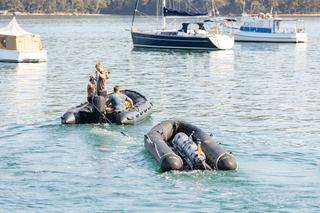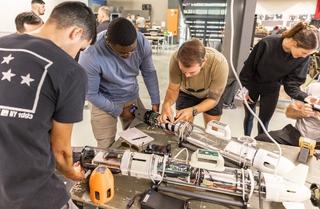Introduction
From September to October 2023, the University of Sydney partnered with the Times Higher Education (THE) World Academic Summit to explore how regional, national and global collaboration can strengthen the role of universities as drivers of change within society. As part of the Summit, the United States Studies Centre (USSC) hosted two major roundtables with university, business and senior government leaders from Australia, the United Kingdom and the United States.
These roundtables focused on the education sector’s value proposition for AUKUS and prospects for trilateral university cooperation. The first event, delivered in partnership with the University of Nottingham, was chaired by Vice-Chancellor and President Professor of the University of Sydney, Mark Scott AO and University of Nottingham Vice-Chancellor, President Professor Shearer West and attended by 40 representatives. The second was a closed-door session for US officials and Australian university stakeholders attended by 12 representatives.

The following summarises these discussions and surveys (15) key findings, traversing themes including strategic messaging and social license, government demand signals and collaboration, workforce and the role of universities in AUKUS research and development (R&D). The findings highlight opportunities and challenges central to realising the promise of AUKUS, as characterised by university, business and government stakeholders. Addressing these will be essential to unlocking barriers to coordinated trilateral university support.
Strategic messaging and building social license
1. Universities as enablers of operationalising the strategic intent around AUKUS
Universities across the three countries agree they are well-placed to add value to government through strategic messaging and building social license for AUKUS. Indeed, university representatives describe themselves as “enablers of operationalising the strategic intent around AUKUS”, or, in other words: building social license for AUKUS. They intend for this to be delivered through two primary inputs: (1) educating the workforce; and (2) Pillar II advanced capability research. However, this dynamic cuts both ways, to educate the AUKUS workforce universities must mobilise a large cohort of stakeholders behind this significant national security endeavour. A task of this scale requires direct government engagement, yet as one senior official quipped: “the processes aren’t in place to support that yet.”
2. Challenges in the Australian context
Social license
Stakeholders agree the challenge of building social license for AUKUS is particularly acute in the Australian context, where government discourse has been constrained by the need to reestablish diplomatic relations with China. Consequently, the nature of strategic competition in the Indo-Pacific and its place in Australian regional strategy for AUKUS is poorly understood by the community. Public opinion polling from numerous sources confirms this thesis. USSC’s own polling, released in late 2023, finds that support for Australia acquiring nuclear-powered submarines has fallen below majority (49 per cent).1 The notion of falling support for AUKUS is corroborated by other major Australian polls, including the Lowy Institute and The Guardian, which find that support has weakened, rather than firmed since the optimal pathway announcement.2
Additional data suggests the challenge of building social license is not as pronounced among the UK and US publics, with polling from the advisory and strategic communications firm, CT group indicating the net favourability score in the United States for sharing US submarine technology with Australia was 54 points, whereas in Australia it was 41 points.3 Likewise, the United Kingdom’s Policy Exchange found there is widespread support across the population for AUKUS, with 54 per cent of the British population believing AUKUS will be a successful deterrent against Chinese aggression in the Indo-Pacific.4 While these comparisons are not perfect, they do give some indication of the differing levels of public support amongst the AUKUS countries and suggest Australia has the most work to do. Research published by USSC analysts suggests that Australian concerns about cost, nuclear waste disposal and safety, workforce and sovereignty will become more pronounced as AUKUS travels along the optimal pathway.5
Nuclear safety
Australian roundtable participants identify nuclear safety as among the most prescient social license concerns and note the high standards the United States and the United Kingdom have set in this regard. While Australian officials underscore limited resistance on this specific component of the arrangement to date, concern does exist around a “not in my backyard” mentality coming into greater focus as the government makes decisions about nuclear waste disposal. The court case won by the Barngarla people against the federal government in July 2023, regarding plans to dispose of nuclear waste on their land, is one example of what may lie ahead.6 Stakeholders agree that developing complementary and easily understood public messaging is integral to building social license in this regard.

3. The value of Pillar II
Universities believe that how AUKUS is linked to the economic development of future industries will be critical to communicating its value proposition to the public. To that end, participants underscore the need to expand the appeal of AUKUS beyond submarines, noting Pillar II provides a unique opportunity to build social license. This is because breakthroughs in Pillar II technologies such as AI and quantum technologies may increase economic value and productivity in the industries of the future.7 To appeal to a wide range of students and researchers, universities recognise they must demonstrate the breadth of Pillar II opportunities beyond Science Technology Engineering and Mathematics (STEM).
4. A “retreat to the Anglosphere”?
While universities are eager to grasp the AUKUS opportunity and to play a leading role in developing social license for AUKUS, they harbour concerns about criticism of the partnership being framed as a “retreat to the Anglosphere.”8 This concern has become more acute following the release of the Australian government’s draft defence trade controls legislation.9 The draft legislation elicited strong reactions from the higher education sector, including the Group of Eight universities, who worry expansive definitions of “fundamental research” will curtail scientific collaboration in dual-use technologies with countries outside of the AUKUS tent, to the detriment of Australia’s broader innovation base.10
Government demand signals needed to catalyse focus and collaboration
5. Channelling focus and trilateral alignment
University and AUKUS stakeholders believe government must demonstrate clear demand signals around AUKUS for two reasons:
- so organisations can channel focus into AUKUS initiatives in a more meaningful way;
- to allow universities to align themselves trilaterally in support of AUKUS.
In the aftermath of the roundtables, the AUKUS partners announced an AUKUS Advanced Capabilities Industry Forum and AUKUS Defence Investors Network to inform advanced capability development, yet Pillar II still lacks a formal coordination function for the research community.11 Should AUKUS governments establish country leads for advanced capability priority areas, participants suggest this division of labour be emulated by universities. This would allow universities to develop more robust patterns of collaboration.
6. Challenges to collaboration and partnerships
Although university collaboration is a necessary condition for AUKUS, and sufficient expertise and capability exists within universities to progress this, participants anticipate two key challenges. Firstly, organisational cultures and bureaucracies will be painfully difficult to join together. Secondly, universities must balance the need to compete with the imperative of cooperation. Participants suggest aligning organisational cultures and bureaucracies will come down to three factors: people, trust and relationships. To assist bureaucratic and cultural integration, universities would like to see government support funded, joint research programs to encourage the sharing of innovation and information — especially for Pillar II. There will inevitably be competition, but if universities are to become trusted strategic partners to government for AUKUS, they must resist their most competitive impulses.
7. Incentivising collaboration
Governments can support university-to-university collaboration by creating greater incentives, including by funding joint research programs, as suggested above, so that partnership has a superior comparative advantage. There are successful existing examples of university collaboration, including AUKUS research and education partnerships involving the Universities of Flinders, Manchester and Rhode Island, as well as King’s College London, the University of New South Wales and Arizona State University.12 Some participants believe a Fulbright-style scholarship exchange could add research value to specific AUKUS initiatives. Moreover, stakeholders anticipate capability mapping of existing expertise may reduce duplication and ease competition. Examples include Australia’s expertise in quantum computing and the United Kingdom’s expertise in advanced cyber.13 Building a docking mechanism — in other words, a rotational guest membership — into research councils may also help deconflict lines of work by improving visibility.
8. Domestic considerations
Facilitating effective collaboration will necessarily involve AUKUS partners and their universities designating areas of expertise at the domestic level. In this regard, universities need to be supported to specialise in specific AUKUS areas. While there are successful examples of this emerging with reference to Pillar I, notably the University of Flinders’ designation as the Australian home for international nuclear expertise, more work needs to be done to ensure universities are directing their resources towards complementary areas.14 Participants agree part of the challenge in Australia is that university-level education is largely uniform, however, they expect targeted AUKUS investment will change the landscape in this regard.
Workforce
9. Universities’ contribution to workforce development (and additional pathways)
Stakeholders agree universities are prepared to play a significant role in AUKUS workforce development, noting they view themselves as the “mobilisers” of the workforce. Certainly, the capacity universities have to connect with counterparts in other AUKUS countries and to move talent across the education ecosystem is a strategic advantage. For example, this could include Australian universities gaining key insights into the design of nuclear engineering master’s degrees in the United States and the United Kingdom. However, collaboration based on existing training methods will not be enough to realise the potential of AUKUS. Participants believe global educational collaboration must be matched with increased industry partnership, work-integrated learning and scholarships to demonstrate a sufficient value proposition to students in a competitive labour market. A recent USSC report, published in December 2023, found efforts in the United States to create “consortiums of training providers”, combining the expertise of universities, colleges, government and industry allowed rapid training of a variety of skilled submarine industrial base workers at scale.15 UK representatives cited the successful integration of trades college and university learning at the University of Sheffield and Advanced Manufacturing Research Centre, which allows apprentices to train in university workshops.16 Taken together, these examples suggest there is merit in breaking out of traditional educational silos.

10. Addressing the STEM issue
Universities continue to raise deep concerns about the lack of students ready for rigorous university study, particularly in STEM fields that will be essential to the AUKUS workforce. Australian participants in particular note the decline of serious maths and higher sciences. National education data suggests almost half of Australia’s year 10 students fail to achieve national standards in these areas, with Australia more than four years behind Singapore, the global leader in mathematics scores among school-aged students.17 When this issue is viewed through a national security lens, it reveals a serious problem for the AUKUS enterprise. Utilising an international workforce to supplement STEM gaps will raise numerous security challenges, previewed in the next paragraph. Participants note the Australian government will need over 2,000 engineers and scientists just to manage and oversee the engineering program for the AUKUS submarines. Some of these workers will need 20 to 30 years of experience in nuclear safety and largely cannot be drawn from the United States or the United Kingdom.
Acknowledging Australia continues to slip further behind its peers in producing STEM-ready graduates stakeholders suggest a reappraisal of current incentives and agree on the need to address this issue from the primary and secondary school level.18 This will require the federal government to work with state governments to improve primary and secondary-level STEM outcomes and address gaps in the vocational education and academic workforce.
11. Security issues
Australia’s security vetting system in its current form is unable to process security clearances at the rate required for existing workloads. AUKUS has only increased this pressure, pointing to the need for serious reform.19 Noting inefficiencies in Australia’s security system, participants warn additional security requirements will become more onerous as US security provisions are necessarily adopted in Australia. The Defence Trade Controls Amendment Bill 2023 is one relevant example. If adopted into law, individuals and entities will be required to apply for permits to supply “controlled goods of technology on the Defence and Strategic Goods List to certain persons or from certain foreign countries”.20 Participants lament compounding workforce security issues and worry that many migrants might not be able to join the AUKUS workforce under current and future security vetting arrangements. This is a risk management issue; however, the current security vetting process is focused on process-based management of risk. This is a ‘one size fits all’ template or ‘box ticking’ approach that undermines the ability to recruit sufficient staff. More focus also needs to be placed on finding creative solutions to the workforce crisis. A recent USSC report published in December 2023, found that high-quality migrant workers could be empowered to fill skills gaps in industries adjacent to AUKUS. This would free up Australian workers who meet appropriate security standards.21 The report also called for greater focus on diversity across the AUKUS enterprise, including the integration of women and other underrepresented groups such as Indigenous Australians to correct historical underutilisation in the workforce and achieve the required scale for the AUKUS enterprise.22
Research and development: Universities as an important third partner in AUKUS innovation
12. Building off a strong research and development base
University stakeholders are an intrinsic third partner to AUKUS Pillar II, with a history of allocating significant capital to defence research and development (R&D) each year. In fact, data from the Group of Eight Universities indicates Australia’s leading universities invest $70 million in defence R&D each year, or 44 per cent of total university sector investment.23 Certainly, this suggests universities are well-placed to contribute to AUKUS R&D, however, participants note additional government funding will be required. UK stakeholders in particular experience difficulties getting funding, even for key defence priorities such as quantum and nanotechnology.
A report published by USSC in 2023, “UPSCALE: Using Private Sector Capital for the Alliance”, found that in contrast to the United States and the United Kingdom, Australian universities have relatively limited relationships with the defence ecosystem.24 The report argued there is considerable scope to broaden and deepen existing relationships, acknowledging that although there has historically been a low ambition to coordinate this is starting to change. Furthermore, the report surfaced two key challenges to greater university collaboration with the defence ecosystem. Firstly, obtaining security clearances in a timely manner and, secondly, Australian universities lack secure labs to work on classified projects. The report highlighted examples of US and UK co-creation labs, including the Johns Hopkins University Applied Physics Laboratory (APL), as models for leveraging greater university input into the defence ecosystem. It also suggested supporting greater two-way flows of human capital between universities and the Department of Defence, in order to bolster mobility and skills development.25

13. Challenges commercialising research and developing capability
Universities identify commercialising research, capability development and manufacturing as key challenges for AUKUS Pillar II. On this score, Australian and UK stakeholders note limited government investment in technology such as quantum, machine learning and robotics, meaning startups and SMEs struggle to manufacture in-country. University stakeholders suggest integrating academic expertise in a more meaningful way along the commercialisation pipeline could alleviate some of these challenges. Participants also pointed to Australian firm, Advanced Navigation as a suitable case study. Despite the company being worth $1 billion and a major exporter of defence systems — including crucial inputs into submarines — it has struggled to manufacture in Australia at scale.26 This example underscores the need to support and match emerging startups and SMEs in the dual-use space with suitable manufacturing partners. A failure to do this could result in firms electing to manufacture in China or elsewhere to achieve economies of scale, leaving them unfit to work with the defence establishment.
14. Revaluating the defence accelerator/ academia nexus
The primary aim of Australia, the United States and the United Kingdom’s respective defence accelerators — the Advanced Strategic Capabilities Accelerator (ASCA), the Defence Innovation Unit (DIU), and the Defence and Security Accelerator (DASA) — is to pull innovative and dual-use technology through to capability at pace. These accelerators will play an important role in supporting AUKUS Pillar II outcomes and yet some participants remain concerned about how effectively they have worked with universities in the past. This is particularly true in the Australian case, underscoring the need to heed lessons from the United States and the United Kingdom.
15. Reconciling intra-country approaches to AUKUS
The three AUKUS partners have differing risk tolerances and expected timelines for Pillar II capability development, highlighting the need to reconcile these to improve R&D collaboration. For example, whereas Australian officials seek Pillar II capability delivery within a two-year timeline, US officials are more tolerant of experimentation — and to see things fail in order to find genuinely innovative capability.27 Australian universities believe they have a unique value proposition in this regard and may be able to absorb some of the latitude that the Department of Defence does not have to progress a more tolerant approach to risk.
The differing risk tolerances and timelines each AUKUS partner has in relation to Pillar II advanced capabilities points to a broader AUKUS collaboration challenge that underscores each finding in this report: aligning intra-AUKUS expectations and approaches. If Australia, the United States and the United Kingdom can bridge these differences they will succeed in binding together the national interests of each nation within one AUKUS ecosystem, encompassing critical workforce, research and innovation nodes. Supported by trinational economic, political and military resources this ‘AUKUS grand strategy’ will lead to a safer and more secure Indo-Pacific region.








